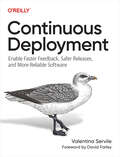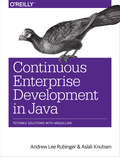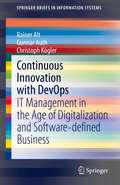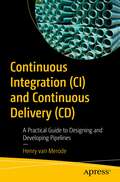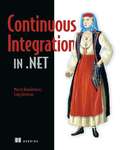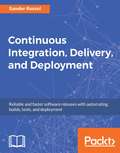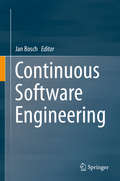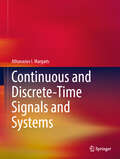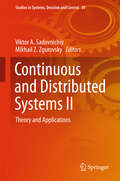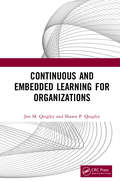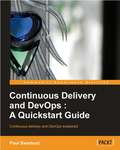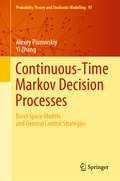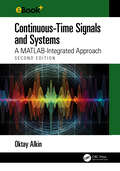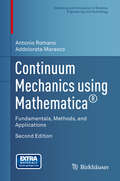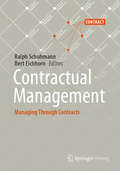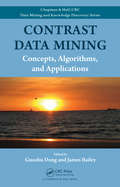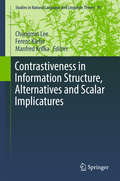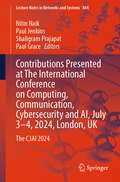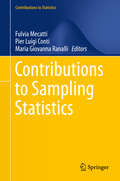- Table View
- List View
Continuous Deployment: Enable Faster Feedback, Safer Releases, and More Reliable Software
by Valentina ServileMethods of delivering software are constantly evolving in order to increase speed to market without sacrificing reliability and stability. Mastering development end to end, from version control to production, and building production-ready code is now more important than ever. Continuous deployment takes it one step further. This method for delivering software automates the final step to production and enables faster feedback and safer releases.Based on years of work with medium to large organizations at Thoughtworks, author Valentina Servile explains how to perform safe and reliable deployments with no manual gate to production. You'll learn a framework to perform incremental, safe releases during everyday development work, structured exclusively around the challenges of continuous deployment in nontrivial, distributed systems. Complete with interviews and case studies from fellow industry professionals.Close the feedback loop and leverage the production environment to manage your end-to-end development lifecycle efficiently. This book helps you:Take observability, performance, test automation, and security into account when splitting work into incrementsCreate a daily development plan that takes immediate deployments to production into accountDeploy work in progress to production incrementally without causing regressionsUse patterns to refactor live functionality and alter persistence layersTest and release features in production using different feature toggle configurations
Continuous Enterprise Development in Java: Testable Solutions with Arquillian
by Andrew Lee Rubinger Aslak KnutsenLearn a use-case approach for developing Java enterprise applications in a continuously test-driven fashion. With this hands-on guide, authors and JBoss project leaders Andrew Lee Rubinger and Aslak Knutsen show you how to build high-level components, from persistent storage to the user interface, using the Arquillian testing platform and several other JBoss projects and tools.Through the course of the book, you’ll build a production-ready software conference tracker called GeekSeek, using source code from GitHub. Rubinger and Knutsen demonstrate why testing is the very foundation of development—essential for ensuring that code is consumable, complete, and correct.Bootstrap an elementary Java EE project from start to finish before diving into the full-example application, GeekSeekUse both relational and NoSQL storage models to build and test GeekSeek’s data persistence layersTackle testable business logic development and asynchronous messaging with an SMTP serviceExpose enterprise services as a RESTful interface, using Java EE’s JAX-RS frameworkImplement OAuth authentication with JBoss’s PicketLink identity management serviceValidate the UI by automating interaction in the browser and reading the rendered pagePerform full-scale integration testing on the final deployable archive
Continuous Fuzzy Evaluation Methods: A Novel Tool for the Analysis and Decision Making in Football (or Soccer) Matches
by Ranjit BiswasThis book presents a proposal for a new soft computing innovative method called by “CFE” forevaluation of the football matches of FIFA(IFAB) and UEFA to compute the true ‘Winner’. It is a research work in the area of ‘Football Science’, being proposed to FIFA (IFAB) and UEFA, Zurich, Switzerland for consideration to replace the existing obsolete and weak rules of football matches of 90 minutes to declare the final ‘Winner’. In CFE, the final decision about any football match of 90 minutes is obtained “by computation”, by execution of a software called by ‘CFE-software’ with the real time input values directly from the field on a number of highly significant parameters, some of them being continuous variables. The result of m-n goals at the end of 90 minutes play in a football match is just one of the many parameters for the computation of the ‘Winner’ in our proposed CFE method. The evaluation is mainly based upon the application of Fuzzy Logic, ‘Fuzzy Pocket Machine’, fast Computer Server, good Communication system from playing-field to the server (as used in Cricket matches) and the CFE-software at the server. The Referees need not be experts in fuzzy set theory; they can be easily trained within just 30 minutes of demonstration on : how to use the ‘fuzzy pocket machine’ for giving real time inputs to the database at the server.
Continuous Innovation with DevOps: IT Management in the Age of Digitalization and Software-defined Business (SpringerBriefs in Information Systems)
by Rainer Alt Gunnar Auth Christoph KöglerThis book connects the new world of digitalization with classic IT management. With the presence of software in objects, products and processes, most businesses will become software-defined businesses. Software development and software management are thus key to stay competitive in an environment that demands continuous innovation. The authors provide a comprehensive introduction to continuous innovation, the DevOps concept and lay the foundations of an innovation-oriented IT management. The DevOps approach to continuous innovation, which combines lean and agile concepts with an automated tool chain, enables solutions that synergize fast (re)action through digital innovation on the one hand and long-term development cycles and stable operation on the other. A comprehensive case study of T-Systems MMS, a digital service provider from Deutsche Telekom in Germany, illustrates the use of this approach in practice.
Continuous Integration (CI) and Continuous Delivery (CD): A Practical Guide to Designing and Developing Pipelines
by Henry van MerodeUse continuous Integration (CI) and continuous delivery (CD) to improve the speed of software delivery. This book presents a game changer—how to use pipelines to automate the software delivery process. The theories about CI/CD are much the same, but the book covers what the development of pipelines looks like and how testing of pipelines themselves should be performed.Most teams just plunge into coding, without thinking about the CI/CD process itself. Why don’t we use the same development method for pipelines that we use for apps? Pipelines code development undergoes similar stages as application code development, such as requirements analysis, development, testing, implementation, operations, and monitoring. This is the starting point of the book. It describes the current challenges with pipeline development and how this process can be improved and structured. It describes in detail how to design pipelines and shows examples in BPMN 2.0 notation. What You’ll Learn Know the shortcomings and challenges of current pipeline development such as misalignment between the pipeline engineer and the team’s workflow, the use of infrastructure as code (IaC), and pipeline securityUnderstand the need for CI/CD requirements through the book's non-exhaustive list of more than 60 CI/CD requirements provided to inspire and increase awarenessSee how certain choices affect the way a pipeline is designed (and realized)Become familiar with branching strategy, build strategy, test strategy, release strategy, and deployment strategy that are explained in detail in the book, including their effect on pipeline designKnow how pipelines can be unit tested, using a real-world exampleKnow how performance bottlenecks in a pipeline occur, how they can be detected, and how they can be solvedView a complete implementation, including code, showing how the guidelines in this book are applied to a real use case Who This Book Is For DevOps engineers and solution architects involved with automating the software supply chain and using application lifecycle management (ALM)/integration platforms such as Jenkins, CircleCI, Bamboo, and Azure DevOps; intermediate and experienced DevOps engineers (developers, ops engineers, test engineers); and ICT managers interested in the CI/CD pipeline development domain
Continuous Integration in .NET
by Craig Berntson Marcin KawalerowiczContinuous integration is a software engineering process designed to minimize "integration hell." It's a coordinated development approach that blends the best practices in software delivery. For .NET developers, especially, adopting these new approaches and the tools that support them can require rethinking the development process altogether.Continuous Integration in .NET is a tutorial for developers and team leads that teaches readers how to re-imagine their development strategy by creating a consistent continuous integration process. This book shows how to build on the tools they already know - .NET Framework and Visual Studio - and to use powerful software like MSBuild, Subversion, TFS 2010, Team City, CruiseControl.NET, NUnit, and Selenium. Purchase of the print book comes with an offer of a free PDF, ePub, and Kindle eBook from Manning. Also available is all code from the book.
Continuous Integration, Delivery, and Deployment
by Sander RosselGetting started with the processes and the tools to continuously deliver high-quality software About This Book • Incorporate popular development practices to prevent messy code • Automate your build, integration, release, and deployment processes with Jenkins, Git, and Gulp?and learn how continuous integration (CI) can save you time and money • Gain an end-to-end overview of Continuous Integration using different languages (JavaScript and C#) and tools (Gulp and Jenkins) Who This Book Is For This book is for developers who want to understand and implement Continuous Integration and Delivery in their daily work. A basic knowledge of at least JavaScript and HTML/CSS is required. Knowing C# and SQL will come in handy. Most programmers who have programmed in a (compiled) C-like language will be able to follow along. What You Will Learn • Get to know all the aspects of Continuous Integration, Deployment, and Delivery • Find out how Git can be used in a CI environment • Set up browser tests using Karma and Selenium and unit tests using Jasmine • Use Node.js, npm, and Gulp to automate tasks such as linting, testing, and minification • Explore different Jenkins jobs to integrate with Node.js and C# projects • Perform Continuous Delivery and Deployment using Jenkins • Test and deliver a web API In Detail The challenge faced by many teams while implementing Continuous Deployment is that it requires the use of many tools and processes that all work together. Learning and implementing all these tools (correctly) takes a lot of time and effort, leading people to wonder whether it's really worth it. This book sets up a project to show you the different steps, processes, and tools in Continuous Deployment and the actual problems they solve. We start by introducing Continuous Integration (CI), deployment, and delivery as well as providing an overview of the tools used in CI. You'll then create a web app and see how Git can be used in a CI environment. Moving on, you'll explore unit testing using Jasmine and browser testing using Karma and Selenium for your app. You'll also find out how to automate tasks using Gulp and Jenkins. Next, you'll get acquainted with database integration for different platforms, such as MongoDB and PostgreSQL. Finally, you'll set up different Jenkins jobs to integrate with Node.js and C# projects, and Jenkins pipelines to make branching easier. By the end of the book, you'll have implemented Continuous Delivery and deployment from scratch. Style and approach This practical book takes a step-by-step approach to explaining all the concepts of Continuous Integration and delivery, and how it can help you deliver a high-quality product.
Continuous Software Engineering
by Jan BoschThis book provides essential insights on the adoption of modern software engineering practices at large companies producing software-intensive systems, where hundreds or even thousands of engineers collaborate to deliver on new systems and new versions of already deployed ones. It is based on the findings collected and lessons learned at the Software Center (SC), a unique collaboration between research and industry, with Chalmers University of Technology, Gothenburg University and Malmö University as academic partners and Ericsson, AB Volvo, Volvo Car Corporation, Saab Electronic Defense Systems, Grundfos, Axis Communications, Jeppesen (Boeing) and Sony Mobile as industrial partners. The 17 chapters present the "Stairway to Heaven" model, which represents the typical evolution path companies move through as they develop and mature their software engineering capabilities. The chapters describe theoretical frameworks, conceptual models and, most importantly, the industrial experiences gained by the partner companies in applying novel software engineering techniques. The book's structure consists of six parts. Part I describes the model in detail and presents an overview of lessons learned in the collaboration between industry and academia. Part II deals with the first step of the Stairway to Heaven, in which R&D adopts agile work practices. Part III of the book combines the next two phases, i. e. , continuous integration (CI) and continuous delivery (CD), as they are closely intertwined. Part IV is concerned with the highest level, referred to as "R&D as an innovation system," while Part V addresses a topic that is separate from the Stairway to Heaven and yet critically important in large organizations: organizational performance metrics that capture data, and visualizations of the status of software assets, defects and teams. Lastly, Part VI presents the perspectives of two of the SC partner companies. The book is intended for practitioners and professionals in the software-intensive systems industry, providing concrete models, frameworks and case studies that show the specific challenges that the partner companies encountered, their approaches to overcoming them, and the results. Researchers will gain valuable insights on the problems faced by large software companies, and on how to effectively tackle them in the context of successful cooperation projects.
Continuous and Discrete-Time Signals and Systems
by Athanasios I. MargarisThis textbook provides a detailed study of continuous and discrete time signals and systems, at a theoretical as well as a practical level, for undergraduate as well as graduate students. The book follows a didactic approach, allowing the students to acquire a solid knowledge and skill required for the study of more advanced subjects, such as telecommunications, as well as automatic control systems. The detailed presentation of the theory in this book is accompanied by many examples, as well as hundreds of solved and unsolved exercises, that help the reader to gain immediately a deep understanding of the presented material and the way it is used in practice. Because of the mathematical complexity associated with the presented material, this book requires a good knowledge of basic concepts from linear algebra and mathematical analysis, such as, for example, elements of matrix theory, the concepts of the derivative and the integral, as well as the knowledge of the main aspects associated with differential and difference equations for the continuous and the discrete time domain, respectively. Special emphasis should also be given to well known techniques that allow the estimation of the inverse transforms, such as polynomial division, partial fractions expansion, as well as the methods of residues for the estimation of integrals of complex functions.
Continuous and Distributed Systems II: Theory and Applications (Studies in Systems, Decision and Control #30)
by Mikhail Z. Zgurovsky Viktor A. SadovnichiyAs in the previous volume on the topic, the authors close the gap between abstract mathematical approaches, such as applied methods of modern algebra and analysis, fundamental and computational mechanics, nonautonomous and stochastic dynamical systems, on the one hand, and practical applications in nonlinear mechanics, optimization, decision making theory and control theory on the other. Readers will also benefit from the presentation of modern mathematical modeling methods for the numerical solution of complicated engineering problems in biochemistry, geophysics, biology and climatology. This compilation will be of interest to mathematicians and engineers working at the interface of these field. It presents selected works of the joint seminar series of Lomonosov Moscow State University and the Institute for Applied System Analysis at National Technical University of Ukraine "Kyiv Polytechnic Institute". The authors come from Brazil, Germany, France, Mexico, Spain, Poland, Russia, Ukraine, and the USA.
Continuous and Embedded Learning for Organizations
by Jon M. Quigley Shawn P. QuigleyThere is considerable connection between growth of the personnel in the organization and the ability for the company to compete over time. Looking outside for help training may be required but looking within for opportunities for enhanced training and growth, will foster a continually improving and growing organization. This book examines the opportunities for learning, within the organization and its’ activities, along with the connection to motivation. Additionally, it provides information on the characteristics of organizations that are able to quickly disseminate, along with approaches for improving this distribution of that learning throughout the organization.
Continuous delivery and DevOps: A Quickstart guide
by Paul SwartoutThis book is both a practical and theoretical guide detailing how to implement continuous delivery and Devops to consistently ship quality software quickly. Whether you are a freelance software developer, a system administrator working within a corporate business, an IT project manager or a CTO in a startup you will have a common problem; regularly shipping quality software is painful. It needn't be. This book is for anyone who wants to understand how to ship quality software regularly without the pain.
Continuous-Time Markov Decision Processes: Borel Space Models and General Control Strategies (Probability Theory and Stochastic Modelling #97)
by Yi Zhang Alexey PiunovskiyThis book offers a systematic and rigorous treatment of continuous-time Markov decision processes, covering both theory and possible applications to queueing systems, epidemiology, finance, and other fields. Unlike most books on the subject, much attention is paid to problems with functional constraints and the realizability of strategies.Three major methods of investigations are presented, based on dynamic programming, linear programming, and reduction to discrete-time problems. Although the main focus is on models with total (discounted or undiscounted) cost criteria, models with average cost criteria and with impulsive controls are also discussed in depth.The book is self-contained. A separate chapter is devoted to Markov pure jump processes and the appendices collect the requisite background on real analysis and applied probability. All the statements in the main text are proved in detail.Researchers and graduate students in applied probability, operational research, statistics and engineering will find this monograph interesting, useful and valuable.
Continuous-Time Signals and Systems: A MATLAB-Integrated Approach, Second Edition
by Oktay AlkinDrawing on author’s 30+ years of teaching experience, ”Continuous-Time Signals and Systems: A MATLAB Integrated Approach” represents a novel and comprehensive approach to understanding signals and systems theory. Many textbooks use MATLAB as a computational tool, but Alkin’s text employs MATLAB both computationally and pedagogically to provide interactive, visual reinforcement of fundamental concepts important in the study of continuous- time signals and systems.In addition to 210 traditional end-of-chapter problems and 168 solved examples, the book includes hands-on MATLAB modules consisting of: 77 MATLAB-based homework problems and projects (coordinated with the traditional end-of-chapter problems) 106 live scripts and GUI-based interactive apps that animate key figures and bring core concepts to life Downloadable MATLAB code for most of the solved examples 64 fully detailed MATLAB exercises that involve step by step development of code to simulate the relevant signal and/or system being discussed, including some case studies on topics such as synthesizers, simulating instrument sounds, pulse-width modulation, etc. The ebook+ version includes clickable links that allow running MATLAB code associated with solved examples and exercises in a browser, using the online version of MATLAB. It also includes audio files for some of the examples. Each module or application is linked to a specific segment of the text to ensure seamless integration between learning and doing. The aim is to not simply give the student just another toolbox of MATLAB functions, but to use the development of MATLAB code as part of the learning process, or as a litmus test of students’ understanding of the key concepts. All relevant MATLAB code is freely available from the publisher. In addition, a solutions manual, figures, presentation slides and other ancillary materials are available for instructors with qualifying course adoption.
Continuum Mechanics using Mathematica®: Fundamentals, Methods, and Applications (Modeling and Simulation in Science, Engineering and Technology)
by Antonio Romano Addolorata MarascoThis textbook's methodological approach familiarizes readers with the mathematical tools required to correctly define and solve problems in continuum mechanics. Covering essential principles and fundamental applications, this second edition of Continuum Mechanics using Mathematica® provides a solid basis for a deeper study of more challenging and specialized problems related to nonlinear elasticity, polar continua, mixtures, piezoelectricity, ferroelectricity, magneto-fluid mechanics and state changes (see A. Romano, A. Marasco, Continuum Mechanics: Advanced Topics and Research Trends, Springer (Birkhäuser), 2010, ISBN 978-0-8176-4869-5). Key topics and features: * Concise presentation strikes a balance between fundamentals and applications * Requisite mathematical background carefully collected in two introductory chapters and one appendix * Recent developments highlighted through coverage of more significant applications to areas such as wave propagation, fluid mechanics, porous media, linear elasticity. This second edition expands the key topics and features to include: * Two new applications of fluid dynamics: meteorology and navigation * New exercises at the end of the existing chapters * The packages are rewritten for Mathematica 9 Continuum Mechanics using Mathematica®: Fundamentals, Applications and Scientific Computing is aimed at advanced undergraduates, graduate students and researchers in applied mathematics, mathematical physics and engineering. It may serve as a course textbook or self-study reference for anyone seeking a solid foundation in continuum mechanics.
Contra el futuro: Resistencia ciudadana frente al feudalismo climático
by Marta PeiranoTras advertirnos de los peligros de internet, vuelve Marta Peirano con un nuevo relato antiapocalíptico para construir un futuro esperanzador. Es la historia más vieja del mundo: la de un desastre medioambiental y una tecnología que nos salva. La hemos repetido como un mantra desde el principio de los tiempos porque hasta ahora se ha revelado cierta; somos el animal más peligroso de la sabana, hemos vencido a las bestias, a las tormentas y a la enfermedad. Pero la estrategia evolutiva que nos ha mantenido vivos desde el principio de la misma vida nos empuja ahora al borde de la extinción. Estamos tan atrapados que ya nos parece inevitable. No es un problema técnico. Hay soluciones a nuestro alcance para frenar el calentamiento global. Pero las grandes tecnologías de nuestro tiempo no pueden ayudarnos a gestionar la crisis climática, porque no están diseñadas para ello, sino para gestionarnos a nosotros durante la crisis climática. Este libro habla de las estrategias de acción ciudadana para hacer frente a la aceleración del feudalismo climático y el capitalismo desastre. Un nuevo relato antiapocalíptico para construir un futuro esperanzador. La crítica ha dicho:«Una de las raras periodistas que realmente se ha especializado en la intersección de la tecnología y el poder».Edward Snowden «Marta Peirano es una de las voces más respetadas en nuestro país sobre privacidad y seguridad en internet».Manuel Ángel Méndez, El Confidencial «Marta Peirano es una incitadora a la resistencia ciudadana. Es la única periodista que analiza la relación entre la Tecnología y el Poder».Mamen Mendizábal
Contract Testing in Action: With Pact, PactFlow, and GitHub Actions (In Action)
by Marie Cruz Lewis PrescottContract testing is a simple, reliable way to make sure that each service and API plays nice with other components so you can deploy independently and safely.Large, loosely coupled systems have hundreds, even thousands, of interactions—and traditional testing can often struggle to keep up! Enter contract testing. This rapidly growing new approach checks API and service compatibility by verifying it against an agreed contract. No more unexpected integration issues, and no more breaking things in production! In Contract Testing in Action you&’ll learn: • The core concepts and practices of contract testing • Testing microservices with Pact • Consumer-driven and bi-directional testing • Building a contract testing framework • Converting API integration tests to contract tests Contract Testing in Action introduces the practice of contract testing through engaging hands-on examples. You&’ll learn how to introduce contract tests for multiple different types of communication, from REST APIs to event-driven architecture. By the end of this practical guide, you&’ll be comfortable with advanced contract testing concepts like can-i-deploy, provider states, and webhooks. You&’ll even get tips on how to introduce contract testing to your team and other business stakeholders. About the technology It&’s difficult to test API and event-based services that can be used by many applications simultaneously through a complex network of integrations. Contract testing offers a straightforward solution. API and service compatibility are verified against agreed-upon contracts that each component in the system—and the developers that build them—can understand and respect. This transformative technique helps uncover integration issues early and adds vital transparency to any system. About the book Contract Testing in Action makes it easy for your team to adopt contract testing for microservices and other API-centric systems. You&’ll start by learning how contract testing fits into the software development lifecycle, and then you&’ll explore practical methods to integrate it with your own tech stack and practices. You&’ll use leading contract testing tools—including Pact, PactFlow, and GitHub Actions—to build your own contract testing framework, set up consumer-driven contract testing for REST and GraphQL APIs, and integrate it into your CI/CD pipeline. What's inside • Testing microservices with Pact • Consumer-driven and bi-directional contract testing • Building a contract testing framework • Converting API integration tests to contract tests About the reader For software developers and quality engineers who have worked with Java or JavaScript, and APIs. About the author Marie Cruz is a Software Tester with over ten years of experience and also a Developer Advocate at Grafana Labs. Lewis Prescott is a Test Specialist at IBM with over nine years experience in software testing.
Contract Theory for Wireless Networks (Wireless Networks)
by Zhu Han Yanru ZhangThis book presents theoretical research between wireless communications, networking, and economics using the framework of contract theory. This work fills a void in the literature by closely combining contract theoretical approaches with wireless networks design problems. Topics covered include classification in contract theory, reward design, adverse selection, and moral hazard. The authors also explore incentive mechanisms for device-to-device communication in cellular networks, insurance plans for service assurance in cloud computing markets with incomplete information, multi-dimensional incentive mechanisms and tournament based incentive mechanisms in mobile crowdsourcing. Financial applications include financing contracts with adverse selection for spectrum trading in cognitive radio networks and complementary investment of infrastructure and service providers in wireless network visualization. This book offers a useful reference for engineers and researchers in the wireless communication community who seek to integrate the notions from contract theory and wireless engineering, while emphasizing on how contract theory can be applied in wireless networks. It is also suitable for advanced-level students studying information systems or communications engineering.
Contractual Management: Managing Through Contracts
by Bert Eichhorn Ralph SchuhmannThe Concept Contractual Management offers a holistic approach to managerial decision-making based on contracts or business processes that are related to contracts. It explains management from the point of view of the contract, just as it interprets the contract from the point of view of management. Thus, the approach highlights the great inherent potential of contracts for managing companies, transactions and business relationships. The book addresses students as well as practitioners and gives insights into the usage of contracts to manage companies or relationships. It covers contract handling from preliminary deliberations to negotiations, implementation, and all the way to the evaluation of the contract within the company. Furthermore, it provides competencies to design and implement a contract and to organize the relevant processes. The Content In Part 1, the book explains the theoretical foundations of Contractual Management; in Part 2, the application of the approach is illustrated through case studies which cover various sectors, industries, company sizes, contract types, and management situations. Theory part: Contractual Management – A Holistic Approach to a Diverse Issue. Case study part: 11 case studies arranged according to specific contract-related topics: Information and Communication – Change – Enterprise Networks – Conflict – Accounting and Financing – Legal Compliance – Societal Steering. The Editors Professor Dr. Ralph Schuhmann: After holding a senior management position in industry, Ralph Schuhmann now teaches Business Law at Ernst-Abbe-Hochschule in Jena, Germany. He is the scientific director of the Contractual Management Institute at SRH Hochschule Berlin and has published various articles on contract law and contract management. Professor Dr. Bert Eichhorn: Before his appointment as professor for International Law and Business Law at SRH Hochschule Berlin, Bert Eichhorn worked as a legal consultant at the EU Parliament and as a lawyer. He has published numerous articles in national and international scientific journals in the area of contract management and international law. He is the managing director of the Contractual Management Institute at SRH Hochschule Berlin.
Contrast Data Mining: Concepts, Algorithms, and Applications (Chapman & Hall/CRC Data Mining and Knowledge Discovery Series)
by James Bailey Guozhu DongA Fruitful Field for Researching Data Mining Methodology and for Solving Real-Life ProblemsContrast Data Mining: Concepts, Algorithms, and Applications collects recent results from this specialized area of data mining that have previously been scattered in the literature, making them more accessible to researchers and developers in data mining and
Contrastive Analysis of Discourse-pragmatic Aspects of Linguistic Genres (Yearbook of Corpus Linguistics and Pragmatics #5)
by Karin Aijmer Diana LewisThis volume will give readers insight into how genres are characterised by the patterns of frequency and distribution of linguistic features across a number of European languages. The material presented in this book will also stimulate further corpus-based contrastive research including more languages, more genres and different types of corpora. This is the first special issue of the Yearbook of Corpus Linguistics and Pragmatics, a publication that addresses the interface between the two disciplines and offers a platform to scholars who combine both methodologies to present rigorous and interdisciplinary findings about language in real use. Corpus linguistics and Pragmatics have traditionally represented two paths of scientific thought, parallel but often mutually exclusive and excluding. Corpus Linguistics can offer a meticulous methodology based on mathematics and statistics, while Pragmatics is characterized by its effort in the interpretation of intended meaning in real language.
Contrastiveness in Information Structure, Alternatives and Scalar Implicatures (Studies in Natural Language and Linguistic Theory #91)
by Ferenc Kiefer Chungmin Lee Manfred KrifkaA group of authors containing both leading authorities and young researchers addresses a number of issues of contrastiveness, polarity items and exhaustivity, quantificational expressions and the implicatures they generate, and the interaction between semantic operators and speech acts. The 19 contributions provide insights on the interplay between semantics and pragmatics. The volume's reach is cross-linguistic and takes an unorthodox multi-paradigm approach. Languages studied range from European languages including Hungarian and Russian to East Asian languages such as Japanese and Korean, with rich data on focus and discourse particles. This volume contributes to a major area of research in linguistics of the last decade, and provides novel, state-of-the-art views on some of the central topics in linguistic research, and will appeal to an audience of graduate and advanced undergraduate researchers in linguistics, philosophy of language and computational linguistics.
Contributions Presented at The International Conference on Computing, Communication, Cybersecurity and AI, July 3–4, 2024, London, UK: The C3AI 2024 (Lecture Notes in Networks and Systems #884)
by Paul Grace Paul Jenkins Nitin Naik Shaligram PrajapatThis book offers an in-depth exploration of cutting-edge research across the interconnected fields of computing, communication, cybersecurity, and artificial intelligence. It serves as a comprehensive guide to the technologies shaping our digital world, providing both a profound understanding of these domains and practical strategies for addressing their challenges. The content is drawn from the International Conference on Computing, Communication, Cybersecurity and AI (C3AI 2024), held in London, UK, from July 3 to 4, 2024. The conference attracted 66 submissions from 17 countries, including the USA, UK, Canada, Brazil, India, China, Germany, and Spain. Of these, 47 high-calibre papers were rigorously selected through a meticulous review process, where each paper received three to four reviews to ensure quality and relevance. This book is an essential resource for readers seeking a thorough and timely review of the latest advancements and trends in computing, communication, cybersecurity, and artificial intelligence.
Contributions to Partial Differential Equations and Applications (Computational Methods in Applied Sciences #47)
by B. N. Chetverushkin W. Fitzgibbon Y. A. Kuznetsov P. Neittaanmäki J. Periaux O. PironneauThis book treats Modelling of CFD problems, Numerical tools for PDE, and Scientific Computing and Systems of ODE for Epidemiology, topics that are closely related to the scientific activities and interests of Prof. William Fitzgibbon, Prof. Yuri Kuznetsov, and Prof. O. Pironneau, whose outstanding achievements are recognised in this volume. It contains 20 contributions from leading scientists in applied mathematics dealing with partial differential equations and their applications to engineering, ab-initio chemistry and life sciences. It includes the mathematical and numerical contributions to PDE for applications presented at the ECCOMAS thematic conference "Contributions to PDE for Applications" held at Laboratoire Jacques Louis Lions in Paris, France, August 31- September 1, 2015, and at the Department of Mathematics, University of Houston, Texas, USA, February 26-27, 2016. This event brought together specialists from universities and research institutions who are developing or applying numerical PDE or ODE methods with an emphasis on industrial and societal applications. This volume is of interest to researchers and practitioners as well as advanced students or engineers in applied and computational mathematics. All contributions are written at an advanced scientific level with no effort made by the editors to make this volume self-contained. It is assumed that the reader is a specialist already who knows the basis of this field of research and has the capability of understanding and appreciating the latest developments in this field.
Contributions to Sampling Statistics (Contributions to Statistics)
by Fulvia Mecatti Pier Luigi Conti Maria Giovanna RanalliThis book contains a selection of the papers presented at the ITACOSM 2013 Conference, held in Milan in June 2013 It is intended as an international forum of scientific discussion on the developments of theory and application of survey sampling methodologies and applications in human and natural sciences. The book gathers research papers carefully selected from both invited and contributed sessions of the conference. The whole book appears to be a relevant contribution to various key aspects of sampling methodology and techniques; it deals with some hot topics in sampling theory, such as calibration, quantile-regression and multiple frame surveys and with innovative methodologies in important topics of both sampling theory and applications Contributions cut across current sampling methodologies such as interval estimation for complex samples, randomized responses, bootstrap, weighting, modeling, imputation, small area estimation and effective use of auxiliary information; applications cover a wide and enlarging range of subjects in official household surveys, Bayesian networks, auditing, business and economic surveys, geostatistics and agricultural statistics. The book is an updated, high level reference survey addressed to researchers, professionals and practitioners in many fields.
